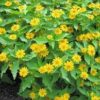**Sunflowers: Nurturing Biodiversity and Ecosystem Harmony**

Sunflowers, with their radiant blooms and abundant nectar, play a vital role in nurturing biodiversity and fostering ecological harmony by providing essential resources for a diverse array of wildlife, including birds, bees, butterflies, and other insects. As keystone species in their native habitats and agricultural landscapes, sunflowers serve as critical sources of food, shelter, and habitat for a wide range of organisms, contributing to the health and resilience of ecosystems worldwide. In this exploration of the interconnectedness between sunflowers and other species, we delve into the rich tapestry of relationships that define their ecological significance and celebrate the beauty and diversity of life they support.
**Nectar and Pollination: A Mutualistic Relationship**
One of the most important relationships between sunflowers and other species is their role in pollination, a vital process that ensures the reproduction of flowering plants and the production of seeds. Sunflower flowers produce nectar, a sweet, sugary substance that serves as a valuable energy source for pollinators such as bees, butterflies, moths, and hummingbirds. As these insects and birds visit flowers in search of nectar, they inadvertently transfer pollen from one flower to another, facilitating the fertilization of ovules and the development of seeds.
Bees, in particular, are highly efficient pollinators of sunflowers, as they collect pollen to feed their larvae and provision their nests. Various species of bees, including honeybees, bumblebees, and solitary bees, play a crucial role in sunflower pollination, ensuring the production of healthy seed crops and the continuation of the plant’s life cycle.
Butterflies and moths also contribute to sunflower pollination, albeit to a lesser extent, as they visit flowers in search of nectar and inadvertently transfer pollen as they move from flower to flower. Additionally, hummingbirds, with their long, slender bills and hovering flight patterns, are important pollinators of sunflowers in regions where they are present, such as North and South America.
**Seed Predators and Dispersers: Sustaining Wildlife Populations**
In addition to pollinators, sunflowers interact with a variety of seed predators and dispersers that play important roles in shaping their population dynamics and dispersal patterns. Birds such as finches, sparrows, and jays are well-known consumers of sunflower seeds, using their strong beaks to crack open the hard outer shell and extract the nutritious kernel inside.
Mammals such as squirrels, chipmunks, and rodents also feed on sunflower seeds, either by foraging on the ground beneath mature plants or raiding bird feeders and agricultural fields where sunflowers are grown. While these animals may be considered pests by farmers and gardeners, they play an important ecological role in dispersing sunflower seeds and contributing to seedling establishment and genetic diversity.
In their native habitats, sunflowers coexist with a variety of seed dispersers, including rodents, birds, and insects, which help spread seeds over long distances and colonize new areas. By dispersing seeds away from parent plants, these animals reduce competition for resources and increase the chances of seedling survival and establishment, contributing to the overall resilience and genetic diversity of sunflower populations.
**Shelter and Habitat: Supporting Wildlife Communities**
Beyond their role in pollination and seed dispersal, sunflowers provide valuable shelter and habitat for a diverse array of wildlife, including insects, birds, and small mammals. Sunflower plants, with their tall stalks and broad leaves, offer refuge for insects such as spiders, beetles, and ants, which inhabit the plant’s stems, leaves, and flowers and prey on pests such as aphids and caterpillars.
Birds also seek shelter and nesting sites in sunflower fields, using the dense foliage and tall stalks to conceal their nests and protect their young from predators. During the breeding season, birds such as blackbirds, finches, and meadowlarks may build nests among sunflower plants, raising their young in the safety of their leafy canopy.
In agricultural landscapes, sunflower fields provide important habitat for wildlife communities, supporting biodiversity and ecosystem resilience in regions where natural habitats have been fragmented or lost. By incorporating sunflowers into crop rotations and agroecosystems, farmers can enhance the ecological value of their fields and promote the conservation of native wildlife species.
**Conclusion**
In conclusion, sunflowers play a crucial role in nurturing biodiversity and fostering ecological harmony by providing essential resources for a diverse array of wildlife species, including pollinators, seed dispersers, and habitat providers. Through their interactions with bees, butterflies, birds, and mammals, sunflowers contribute to the health and resilience of ecosystems worldwide, supporting the web of life that sustains us all. As we celebrate the interconnectedness between sunflowers and other species, we gain a deeper appreciation for the beauty and diversity of life they support and the importance of conserving their habitats for future generations to enjoy.

